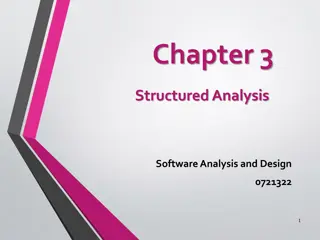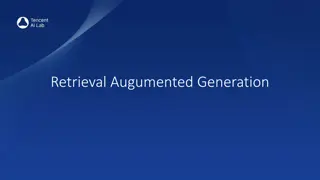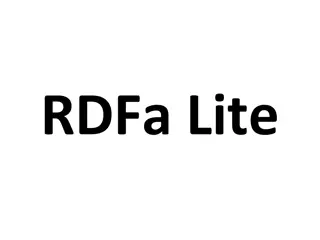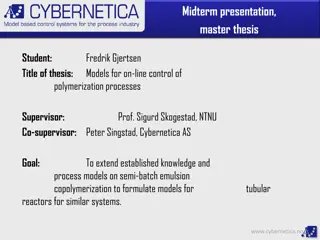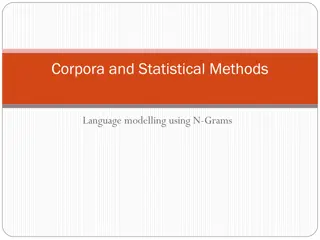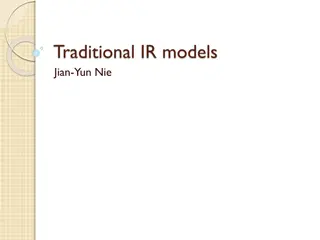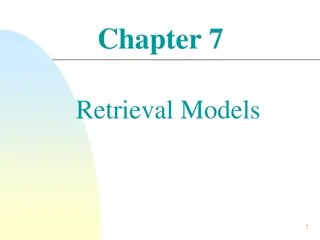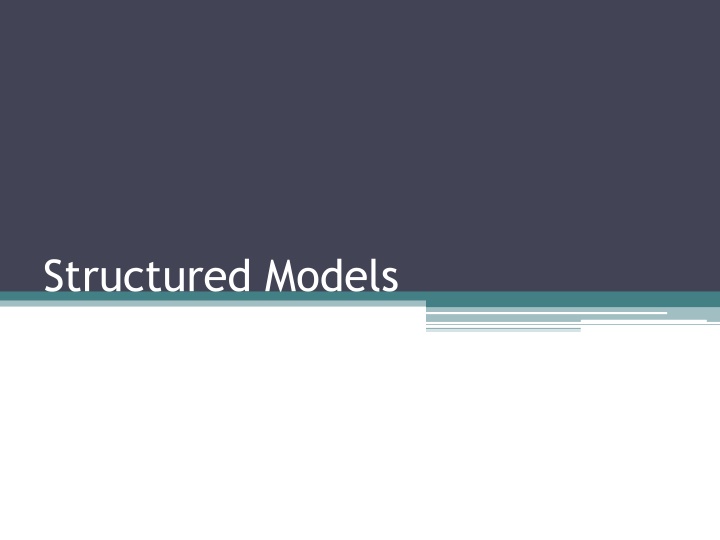
Structural Modeling for Business Analysis
Explore the concept of structural modeling in business analysis, focusing on class diagrams, entity classes, and grouping classes into packages. Learn how to enhance communication between stakeholders and the technical team through informal naming conventions. Discover the importance of defining packages based on common business class categories. Dive into creating a simple list of classes and gathering relevant information for effective modeling.
Uploaded on | 0 Views
Download Presentation

Please find below an Image/Link to download the presentation.
The content on the website is provided AS IS for your information and personal use only. It may not be sold, licensed, or shared on other websites without obtaining consent from the author. If you encounter any issues during the download, it is possible that the publisher has removed the file from their server.
You are allowed to download the files provided on this website for personal or commercial use, subject to the condition that they are used lawfully. All files are the property of their respective owners.
The content on the website is provided AS IS for your information and personal use only. It may not be sold, licensed, or shared on other websites without obtaining consent from the author.
E N D
Presentation Transcript
A structural model is an abstract representation of what the system is. It represents the aspects of a system that are not related to time, such as the kinds of subjects tracked by the system, how these subjects are related to each other, and the information and business rules that relate to each one. The main diagram you ll be using for structural modeling is the class diagram. Output from this step consists of the following: Class diagram Package diagram Composite structure diagram Object diagram
Class Entity Class An entity class is a category of business object, tracked by the system. Rules about Objects and Classes All objects of the same class must share the same operations, methods, and attributes. Name a class with a singular noun phrase, such as Invoice or Retail Customer. Although the UML includes more formal naming conventions, these are more relevant to developers than to business analysts. As a BA, your prime interest is to enhance communication between business stakeholders and the technical team, and an informal naming convention works best for this purpose.
Grouping Classes into Packages If the model contains a large number of classes, it s worth grouping them so they ll be easier to manage. The UML provides the package symbol to stand for a container. We ve seen this before with respect to use cases. Here, we will use the package to contain classes and class diagrams. Class packages may contain other packages for as many levels as necessary. It s helpful to depict all of the packages on a single diagram a simple form of the class diagram. When using a modeling tool such as Rational Rose, it is a good practice to make this the top-level main diagram. Used this way, the diagram acts as a navigation map each package icon links to the class diagram that depicts all of the classes in the package. There is no rule (although there are suggestions 3 ) for how to group the classes into packages. One recommended approach, applicable to many business contexts, is to define packages according to the common flavors of business classes: People and Organizations, Products and Services, and Events/Transactions.
For Now, Focus on the Classes The goal of this step is to produce a simple list of classes. Anything else you pick up at this stage is gravy. For example, if you pick up any attributes now, by all means record them, but don t spend too much time on them. Here are some follow-up questions to ask users about selected classes: Could you provide a brief description of the class? (The description should be one paragraph.) Could you provide a couple of examples of the class? Could you tell me a few pieces of information (attributes) that you d track about each example (object)?
Documents : Class (use a singular noun phrase to name the class) Alias Description Examples Sample attributes Here is an example: Class: Customer Alias: Client Description: Person or company that does business with us Examples: Stan Plotnick, Minelli Enterprises Sample Attributes: Name, Mailing Address, Credit Rating
Model Generalizations The upcoming steps deal with the issue of subtyping. Subtypes allow you to model business objects that share some things in common but have other, distinguishing characteristics. A subtype is a smaller category within a larger category. Subtyping is useful because it allows the business analyst to make statements about automatically apply to all subtypes.You ll need to distinguish between two kinds of subtypes: full-time and part-time. Generalization : Use the generalization relationship to model full-time subtypes. The relationship points from the subtype (specialized class) to the more general type (generalized class). general types that
Rules Regarding Generalization The specialized class inherits all the attributes, operations, and relationships of the generalized class. The specialized class may have additional attributes, operations, and relationships beyond those inherited from the generalized class. The specialized class may have a unique polymorphic method for carrying out an operation it inherits from the generalized class. According to the UML, a specialized class may inherit from more than one generalized class. This is called multiple inheritance. Many IT organizations limit the use of multiple inheritance because it can lead to ambiguities. For example, if a specialized class inherits two methods for the same operation from two generalized classes, which one applies? Check with your organization before using multiple inheritance.
Multiplicity : An indication of the number of objects that may participate in a transient role, association, aggregation, or composite aggregation. In this step, you model business rules that deal with the number of business objects that may be linked to each other. If you don t specify multiplicity, the software may not support important business rules, such as the number of customers who can co-own an account or the number of beneficiaries who can be listed for an insurance policy.
Rules Regarding Multiplicity Indicate multiplicity at every tip of every UML symbol indicating a transient role, association, aggregation, or composite aggregation. Indicate a multiplicity as follows: 0..1 Zero or one 0..* Zero or more * Zero or more (an alternative to 0..*) 1..* One or more 1 One and only one a..b From a through b, as in 1..5
Attributes An attribute is an item of information about an object that is tracked by the business. An attribute is specified at the class level. All objects of that class have the same attributes, but the value of the attributes may differ from object to object. The next step is to find out and document the attributes that are kept by the business for each class. Attributes are part of the user s contract with the developers. If you miss an attribute in your model, you run the risk that the system will not track that attribute. Another reason to indicate attributes is that you then have a place in your model to hang rules about each attribute, such as valid ranges and other verifications.
Sources of Information for Finding Attributes Using the class diagrams as a guide, interview the user about each class. Inspect existing system use cases for references to attributes. For example, the system use case Disburse Payments refers to a Payment Amount an attribute of a Payment. Inspect artifacts created by other members of the project. These include screens, reports, forms, and interfaces to external computer systems. Artifacts such as these are not formally within the scope of the BA because they deal with invention (the how ), whereas the BA is concerned with discovery (the what ). However, the BA should inspect them as they become available because they provide a rich source of attributes: The fields in these artifacts typically represent attributes in the structural model. Inspect business rules expressed in the system use cases or in a separate business rules document. (These rules are sometimes stored electronically in a rules engine.) Sometimes they require new attributes. For example, the Disburse Funds system use case contains a rule that whenever the cash balance falls below a trigger point, a message is to be sent to administration. This rule requires that the Cash Account class have a Trigger Point attribute and a Current Balance attribute.
Rules for Assigning Attributes Check each candidate attribute to ensure that it isn t already listed as a class. Take care to assign the attribute to the right class. The attribute should describe a property of objects in the class. Also, the attribute should be a property that the system tracks individually for each object in the class. List an attribute as far up an inheritance hierarchy as possible. (Keep in mind that if you list an attribute in a generalized class, it must apply to all specialized classes.) For aggregations and compositions, take care to differentiate between an attribute that is related to the whole and an attribute that is tracked at the part level. Attributes that the business tracks about an object regardless of the role are listed with the primary class. Attributes that are kept once for each role are listed with the role. For example, a person s name is kept regardless of one s role, but the date that person became a member of a Peace Committee is recorded once for each Peace Committee membership.
Derived attribute A derived attribute is one whose values can be derived in more than one way from the model. If an attribute can be derived from other attributes in the model, either do not include it or document it as a derived attribute. In the UML, you mark a derived attribute with a slash (/) for example, /extended price. The documentation for a derived attribute should explain how the attribute value is determined from other aspects of the model. For example, /extended price is a derived attribute of an invoice line item that can be calculated from other attributes as follows: /extended price = unit price quantity.
Derived attributes can lead to data integrity problems if they pass unnoticed from the requirements into the database design. For example, consider a student final average that can be derived directly by querying a Final Mark attribute and, indirectly, by calculating it from the student s individual marks. Since there are two ways to derive this mark, there is always the possibility that they will yield different results. One solution (referred to as normalization) prevents the problem by eliminating the Final Mark attribute entirely from the model. If there is no duplication, there is no inconsistency. Eliminating the redundancy also means less storage requirements, since the Final Mark attribute of each student is no longer kept on file but is recalculated as needed. On the other hand, this recalculation uses up system resources at run-time. The decision on how to handle a derived attribute is up to the database designer. But for that person to do his or her job properly, the BA needs to clearly mark which attributes are derived and how they are derived.
Visibility Visibility is a property that can be used to describe a class member. Visibility determines whether other classes can refer to a class member, and whether other objects can see (and therefore use) this attribute or operation. Visibility: The visibility attribute provides the means to constrain the usage of a named element, either in namespaces or in access to the element. It is intended for use in conjunction with import, generalization, and access mechanisms....VisibilityKind enumeration of the following literal values: public; private; protected; package. Visibility is a property of a model element such as a class member. Visibility may have only specific values.These values Public, Private, Protected, and Package describe whether the element can be seen outside of the context in which it is defined. is an
Visibility Options classes may not. Specializations inherit the member but may not refer to it by name. The symbol for private is a minus sign ( ). For example, a specialized CheckingAccount class inherits a private attribute, balance, from a generalized Account class. Every CheckingAccount object will have a Balance attribute but the attribute will be accessible only by operations defined for the Account class. Protected: The rules for a protected member are similar to those for a private member, except that specializations may refer to the member by name. The symbol for protected is a pound sign (#). For example, a specialized CheckingAccount class #AccountNumber, from a generalized CheckingAccount object will have an AccountNumber attribute and be accessible to operations defined in the CheckingAccount class. Public: Any element may access the member. The symbol for public is a plus sign (+). Package: The member is visible to all elements within the nearest enclosing package. Outside the nearest enclosing package, the member is not visible. The symbol for package is a tilde (~). Private: Code for the class may refer to the member by name. Code in other inherits protected Account a attribute, Every class.
Control Classes In this book, we have only dealt with entity classes. Developers add other types of classes to the system, however. One of these is the control class. Ivar Jacobson introduced control classes to address one of the shortcomings of OO 3 . He noted that while it is often easier to modify OO systems than the older structured systems, some changes are more difficult in OO. In particular, OO makes it harder to change the sequencing of the operations required by a system use case. The problem is that, in OO, these operations are scattered among the classes involved in the use case instead of being listed in a single controlling program. To correct the problem, he suggested the addition of a control class to encapsulate, in one software unit, the sequencing logic of a use case. As a rule of thumb, one control class is introduced for each system use case.
Boundary Classes Systems should be insulated as much as possible from changes in other systems. Otherwise, a change in one would create an unacceptable ripple effect on others. The OO approach is to define a boundary class for each external system. This creates a bottleneck to the other system: The only way that the system under design is allowed to communicate with another is by sending a message to the boundary object. The advantage of this approach is that any changes or bugs affecting communication with the external system will be localized in the boundary class and, therefore, easy to fix or modify 4. As a rule of thumb, one boundary class is allocated for each external system and one for each interaction between a human actor and a system use case, as depicted on the system use case diagrams.








